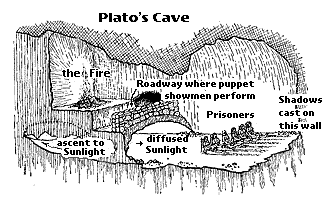Nihilism
The Continuity of Life
Introduction
Together, like waves on the sea, we move in rhythmic pace between office work, supermarket, and family. Our lives are defined, not by their collected share of experience, but of the financial worth according to economical income and material wealth. Every day the massmedia of our society is filling us with new promises about peace, love, and respect, when none of that has yet been seen come true. As the German writer Johann Wolfgang von Goethe noted, all it takes for a human individual to consider death as an alternative, to a life it cannot stand nor bare, is the crossing of the boundaries of his or her own limits.
When we reach this point in life, we lose control over ourselves and feel that we are abandoned by our surrounding, thus in a need to reduce everything around us to a level, which we feel is able to confine under our control. The engineer at work who suddenly loses his mind when his boss continues to bully him in front of his co-workers, the wife who at last have had enough when coming home and seeing her husband in bed with the neighbor, the little boy who runs from home when his stepfather decides to beat him up again; what these people have in common, is that they’ve reached an end point in their lives, where they have to re-consider the things they see as important to their basic existence. The engineer will switch job, the wife will leave her husband, and the little boy will live with his biological father instead. These choices are made, because the individuals in question have broken down the conventions of their daily life, and chosen to look for the most basic of needs, to find out what is draining their energy and what is nurturing it.
Definition
One could say this form of self-reductive process, is a form of philosophical nihilism. Nihilism comes from the Latin word nihil, meaning ‘nothing’ or ‘not anything.’ The most common definition and use of nihilism, is the belief in nothing or a rejection of objective truth, social conventions, and moral meaning. Nihilism as a philosophy goes back several hundred years B.C., when certain philosophers used a scepticist outlook to claim that absolute concepts, like the Christian God, were illusions and thus had to be denied. During the latter half of the 19th Century, nihilism gained both a cultural and political revival, when Russian writers started to reject social conventions such as the traditional family, the church, and the State.
The German philosopher Friedrich Wilhelm Nietzsche developed a larger perspective on nihilism as a phenomenon. He claimed that the West, through science and secular humanism, had “killed God” by proving his non-existence. According to Nietzsche, this would mean that both Heaven was seen as an illusion but also that the Earthly life was a lie, since it had been demonized by the Christian doctrine. He called this “nihilism,” or the state when the West had found that there were no gods up in the sky, but that the current life on Earth also was filthy, immoral, and violent, thus reducing the existential outlook on life to a state of emptiness.
Nietzsche therefore saw nihilism as something horrible and destructive, because it meant the end of the European civilization and cultural life. However, Nietzsche also saw this process as inevitable and therefore attempted to use nihilism as a philosophical tool, a process, in which moral conventions and absolutes, had to pass through his “philosophical hammer.” The idea behind this, was that only true values would survive the beating of the hammer – those that remained dust, were therefore false values. By utilizing this metaphor, Nietzsche – perhaps unintentionally – realized that nihilism, which otherwise to most people seemed as something illogical and dangerous, had potential in creating new values, if used as a process and not an end in itself. Below we will examine this process in depth and explain its relevance to other philosophies.
The Process of Nihilism
Active and Passive Nihilism
We argue that there exists two basic ways of approaching nihilism as a philosophy:
a) Passive Nihilism: Nihilism seen as an end in itself, meaning one strips the outlook on life to reject all established morals, values, and truths, thus finding oneself in a void of emptiness where nothing is real, and thus nothing is worth doing.
b) Active Nihilism: Nihilism seen as a continuous process, meaning one strips the outlook on life of all values, and then create new values out of the void, thus turning nihilism into a form of mental weapon, that one can use to examine different interpretations of reality.
The passive nihilism is essentially what a philosopher would call fatalism; there exists no reality and no truth, thus we as human individuals are trapped within an illusion. One could say this is a form of extreme depression or extreme passive outlook on life, as it claims that the individual lacks any form of free will, since it cannot act upon something that doesn’t exist. Passive nihilism can therefore be seen as us giving up on life, rejecting our potential in acting upon the world, regardless if it is ultimately “real” or not.
This conclusion, that we don’t need to “objectively” affirm everything in order for it to become worth believing in or acting upon, leads us to the nihilism that will be discussed here; the active nihilism. The active nihilist sees nihilism as a sort of mental filter, that kills established norms and values, to examine and re-create an interpretation of an idea, that is closer to reality. Nihilism bypasses moral conventions to study ideas from a causal perspective. Let us systematically, step by step, go through this process:
ParableAccording to Nordic mythology, there was in the beginning of time only a massive hole of emptiness, Ginnungagap. Nothing existed, nothing had ever existed; reality was not. On the one side of the hole laid the world of ice – Nifelhem. On the other side of the hole laid the world of fire – Muspelhem. Inside this large hole, the fire and the ice met and formed a giant creature called Ymer and a cow called Audumbla. These were the two original creatures that together were to become the universe, as we know it today. Why, you may ask, did fire and ice meet to create life? What was the intention, the reason, the “truth,” behind such a creative process? Why did emptiness turn into somethingness?
The passive nihilist rejects all value and claims nothing is real. The logical fallacy here becomes obvious: if we claim to believe in no values, we’ve managed to create a new value; the belief in non-belief. Thus passive nihilism is a self-contradictory state that leads us to the realization, that life is a space in which we as individuals all the time establish new values, derived from the study of the world around us.

ParableJohn and Mike were playing in the forest. They stopped by a giant river and Mike said to John: “Nothing is real, you know. This is all made-up to fool us into thinking we’re living in reality. That river is nonsense; it’s not even there. You’re a fool, John, to believe that this world is real.” John felt angry and in pure rage, pushed his friend down into the river, where he tried to fight against the strong current, but it was of no use. Mike screamed for help, kicked with his legs to remain above surface and catch some air, until he disappeared down into the water and was never seen again.
As active nihilists we wish to examine and study ideas, to find their counterpart in reality and see what is real and what is not. To agree upon something that we can use to find correlation between idea and function in reality, we look for that which we by all means can say is real. The first thing we will find is that physical reality is real. Realism claims that the physical world is the “ultimate reality” or “end reality,” thus a form of space in which the nihilist can test his or her ideas and weed out those who do not match reality.

Parable“And now, I said, let me show in a figure how far our nature is enlightened or unenlightened: –Behold! human beings living in a underground den, which has a mouth open towards the light and reaching all along the den; here they have been from their childhood, and have their legs and necks chained so that they cannot move, and can only see before them, being prevented by the chains from turning round their heads. Above and behind them a fire is blazing at a distance, and between the fire and the prisoners there is a raised way; and you will see, if you look, a low wall built along the way, like the screen which marionette players have in front of them, over which they show the puppets.” (Plato, The Republic (Book VII), The Allegory of the Cave)

In the famous allegory of the cave, the Greek thinker Plato spoke of humans trapped inside a cave, chained to a wall. Behind them was a burning fire that created shadows when things were moving in front of the light. These shadows were cast upon the opposite wall in relation to where the prisoners were chained. The Christians interpreted this as there existed a “pure” abstract world and that the physical world was an illusion. Plato was actually hinting at the opposite: we as individuals create when we interpret physical reality. Words, ideas, truths – these do not “exist” in the actual sense of the word, but are subjective creations that exist only within the mind of individuals. In order to interpret physical reality, we must create symbolic representations of it, in order to try to understand it. This is the basic foundation to all traditional Indo-European religion and philosophy.
What this means, in relation to realism and how we see physical reality, is that our internal, subjective world, and our external, objective world, share a function in the process of life as a whole. The American Nihilist Underground Society describes this as a parable in Love and Nihilism: An Integralist Primer:
The derivation of truth, and attainment of goals in the language of truth, is a process of uniting mind and body that transcends subject/object division. These perceptions are not objective in that they originate and end in the individual, but are stimulated by and acted upon within objective space. The individual, and its thoughts, are part of the mechanism of life.For this reason, moral distinctions such as “mind your own business” and “thou shalt not kill” are meaningless, since they presuppose the barrier between subject and object, and mind and body, to be absolute.
A simple example can be found in nature. A man moves to a distant valley and sets up his house. Because he exists in the external world, he must use it to survive; because he can conceive of the concept of farming, he acts upon this and creates a farm. Yet he attempts to do so in concert with the tendencies of nature, such as seasons and rainfall, so that he may succeed with the minimal amount of friction with the tendency of his world.
It would be false to say his desire was wholly subjective, because it was shaped by the objective. Also false is the idea that it was objective, as it originated in his mind. This is part of the mind/body dualistic paradox that causes us to perceive either that our thoughts are more real than our world, or that we must not act to change our external world because it is divided from our thoughts.
In philosophical terms, this idea is most commonly referred to as idealism, or the belief that the world consists out of ideas, that manifest themselves in physical matter through schematic structures. For instance, think about the chair you’re sitting on right now. It is both a physical object, but at the same time it is built on a certain design, which you could draw on a paper and show your friend, so that he – if he had the skill and the material – could build his own chair and sit down next to you.

So we have concluded that nihilism is the study of physical reality, through a process of extreme scepticism that kills false values and re-creates new ones, that share a function with its counterpart in reality. This means that we over time will build a large amount of ideas, based on structures we’ve found to describe how mechanisms in reality function. The study of structures is fittingly called structuralism. Structuralism is at core a theory that claims that no individual symbols, values, truths, or words, carry an internal meaning in itself. The only way, says the structuralist, to create meaning, is to place individual symbols within larger structural contexts.
An example is our language: what does the word ‘kill’ mean to You? Quickly we realize the fallacy here: ‘kill’ can for instance be seen as positive, as in “I killed the thief that broke into my house and raped my wife,” or be seen as negative, as in “I killed my best friend because I envied his family.” This example is not a way of saying “this is right / this is wrong,” but a way of demonstrating how individual words can have different meanings, depending on the context that they are placed within.
Our ideas and “truths” work the same way: they are only given a functional meaning when they are understood as parts of a larger structural idea. A five-dollar bill is not worth anything in Norway, since Norway doesn’t deal with American dollars, but in America you’d be able to purchase a pack of seeds for the birds living in the tree next to your house. The active nihilist is thus at the same time a structuralist, that wants to improve his or her way of finding structures in reality and creating a representation for them, in order to form beliefs and ideas that are as realistically as possible.
Integralism
~
The Continuity of Life via Philosophical Nihilism
~
The Continuity of Life via Philosophical Nihilism

When we understand nihilism as a way of determining realistic ideas and values, we also understand ourselves as part of something larger and greater. Our world is no longer a space full of trees and birds, but of complex systems that determine the course of the creatures living here. The material world is to the idealist, not an end in itself, but a playground in which we can create and destroy, by changing the underlying ideas. We stretch a bow and shoot an arrow, hitting a deer in the forest. The physical body will decay within months and turn into earth, but no ideas were actually “killed.” In science we often say that universe is energy, and that this energy cannot be destroyed, nor that we can create “new” or more energy, only re-form the energy we have.
This means that while all physical matter, like our body, is transient and eventually will become something else, ideas like cultural values, symphonies, paintings, and ideals, can remain intangible but eternal. We cannot “feel” or “touch” a symphony, but the composer can write down notes, reflecting certain tones played on an instrument, on a paper, and if read by a skilled musician, be remembered and passed on to future generations to come, that will be able to listen to the symphony, performed by an orchestra and a conductor. More or less all European philosophers have claimed that this is the only way to reach immortality: to create something lasting that will live on beyond our mortal lives. Ludwig van Beethoven’s music is still alive, so are the paintings of Casper David Friedrich, and the writings of Johann Wolfgang von Goethe. Their bodies are gone but their ideas – their art – is still alive and praised around the world. They’ve reached immortality through idealism.
As idealists we understand that we are not to live on this planet forever. We will all die and are in fact only part of a great organic cycle, without inherent “purpose” or “meaning” behind it. It just is. If we dare to face our own mortality and the possibility of preserving our planet for future generations, we will place the order in which we live above our own immediate existence, as it is the source of all our pleasures, dreams, and possibilities. Without it we wouldn’t be. This is called integralism: the belief in Life as a whole. Just as an infant would not hurt the womb that brought it life and nurtured it, claims the integralist, we as human beings must fight for life as a continuous process, including our planet and its ecosystems. The human individual is thus no longer a sacred absolute, which no one may kill or hurt, but a part of a larger life that is far more important. We call this the final realization of a mature active nihilist: integralism, the continuity of life, via philosophical nihilism.
Nihilism and Impact – a CORRUPT perspective

Nihilism as a belief system has gained popularity in recent years as the futility of a belief system in human society has seeming gone awry. We went from having not enough civilization and civilized morals in our lives, to having lives that are almost nothing but moral and sentimental messages from society. Thus we are both conditioned toward social objectives, and determined to avoid them, forming a paradoxical state of mind.This mental worldview is hard on people of a logical mindset, as they find themselves rebelling against anything which does have positive value, yet sickened with fear of that which they sense as negative, thus constantly in a loop shuttling between fear and inflated self-vision as “good.” Many are finding nihilism is a logical solution to this problem. The nihilist strips away all of the values but the most basic materialist concepts: I am here and alive. This x will hurt me if I get too close to it, and this y is generally safe to eat. W is a firm friend and I trust him; Z has done nothing but borrow money to buy drinks. (Center for Nihilist and Nihilism Studies, About Nihilism)
The quoted text above describes how nihilism can be applied to human thinking in our daily lives. At CORRUPT we believe that modern society has turned subjective interpretation of reality, into a “world” in itself, in order to try to control the uncomfortable sides of our existence, such as death, inequality, war, hate, struggle, natural selection etc. This means that we have created a CORRUPT society that no longer upholds realistic values and ideals.
Nihilism, in our view, is an effective way of reducing the modern worldview to the most basic set of values that coincide with our natural reality. We believe that nihilism can be used to avoid depression, self-defeatism, guilt, passivity, and other forms of psychological neurosis that are so common in our modern time. Because most of these inner problems stem from different forms of fatalism, nihilism can effectively bypass that and look beyond the fancy symbols and holy promises of our current society.
NORMAL: DID YOU HEAR HOW BUSH STOLE THE ELECTION?NIHILIST: OH, THEY’RE STEALING ELECTIONS NOW. HOW FUNNY. DID YOU KNOW BELL PEPPERS ARE A GOOD SOURCE OF VITAMIN C?
NORMAL: OMFG I HEARD AL-QAEDA IS PLANNING TO ATTACK US!
NIHILIST: YOU KNOW, VAN GOGH REALLY CAPTURED THE ESSENCE OF SUSPENSE IN HIS SURREALISTIC PAINTINGS. MIGHT BE A GOOD TIME TO CHECK THEM OUT.
NORMAL: GASOLINE IS TOTALLY EXPENSIVE THESE DAYS.
NIHILIST: MONEY EVERYWHERE. I MADE AN INTERPRETIVE SCULPTURE OUT OF MY COMPOST HEAP. (Vijay Prozak, How does a nihilist live?”)
All practical and psychological benefits of nihilism is beyond the scope of this document. Instead we wish to point to general suggestions on how nihilism can be applied to every day life:
– Crowd mentality: A group of people try to enforce a certain idea by justifying it on the ground that many people agree with the proposed idea. Modern society is full of this, from Democracy, where people vote on a belief and claim it’s good because a majority like it, to utilitarian thought, that says our society is “progressive” because it manages to make most people “happy” through television and jobs. A nihilist denies these thoughts and sees them for what it is: “a mass of individuals that appeal to numbers, in order to prove that their idea is truth, while reality says this is a logical fallacy. You cannot replace leadership with symbolic votes, no matter how many people that participate in an election!”
– Depression: An extreme form of fatalism, that has created a negative circle from which the individual cannot seem to escape. Nihilism frees us from this and opens up our eyes to something larger: “we can bypass our depression and passivity by creating new values and finding things in life we deem as important and beautiful, like nature, art, struggle, and love.”
– Existential crisis: Existentialists like Sartre claimed that the human individual had complete control over its choice of values applied to phenomenon’s in reality, meaning that the individual alone had to create a meaning with his or her own life. These choices created a form of anxiety that was inevitable for this existential condition. Many people today feel, not happy or rewarded by all the “choices” we have in modern society, but anxious and confused by all the alternatives that lay before us. What do we want? What is our purpose? The nihilist says that “free will” is not interesting: “we must find the things we feel are important to our lives, regardless of the alternatives. If you walk into the supermarket and want to buy lettuce, and find that only one piece of lettuce is healthy and the others are rotten, which significance has ‘freedom of choice’ in that particular situation? You choose the healthy lettuce and walk away with a smile on your face, while other people will stand there and study colour, shape, and smell, to anxiously decide what lettuce they wish to bring home. We don’t need more choices, we need the right choices.”
– Disconnection: Our suburban cities are placed far away from green forests and blue lakes, thus many people today cannot relate to nor understand the beauty and wisdom of nature, as they’ve disconnected from it and spend their lives in front of computers, televisions, and office desks. Nihilism penetrates the illusions we fabricate while we find our existence boring and pointless: “money and material pleasures do not satisfy us in the long run,” claims the nihilist, “we need to return to nature and live lives that are more fulfilling and meaningful. We must re-reconnect our lives to nature, not only to understand our own life better, but also to learn how to appreciate beauty in things that also may seem violent or dangerous. A bird eating another bird, is it “evil”, or just another inseparable mechanism of the process of life?”
– Hedonism: Many people feel their lives lack meaning, so they do their best to fill that vacuum, by following their material desires, leading to an excessive hedonistic lifestyle of shallow sex, lots of fast-food and television, many social events with false friends, and political groups where people scream the same symbolic message, and congratulate themselves for being “modern.” The nihilist says that tangible material pleasures only constitute as temporary escapism: “You may enjoy this evening with a man you find attractive and have sex with him because of that, but when you wake up the next morning and look yourself in the mirror, a cold and dead face will stare back at you. You’ve become an empty shell that hates itself and find no reason to keep on living, except for the next time you’ll have sex again.”
– Self-defeatism: Life is hard. Today we see animals being tortured, entire forests being cut down and turned into fire wood for industries, children growing up depressed and fatalistic, elderly being robbed and beaten up on the streets, families breaking up and going separate ways; where is hope? Where did our glorious future go? Is this “progress?” “There is no positivistic ‘progress’,” says the nihilist, “history shows that civilizations function like human beings, that both enter life and eventually die, when the time is up. Struggle is a necessary part of life. We must learn to appreciate the horrors and dangers of life, to move past them and look beyond something greater. Nature is being killed, but we can stop it, even if it’s horrible and we are only individuals. We can make it, if we collect the power within ourselves and work with others, to help fight what we see as wrong.”
– The moral God: Modern Christians hover between the Christian morality and the functions of reality, like the difference between “Thou shalt not kill” and watching a bear slicing and dicing his fish to survive. The nihilist exclaims: “God is not in an external heaven, separated from our world, but a part of our natural reality. Thus his moral laws coincide with those of how reality operates. I pledge alliance only to the God that is found within nature!”
– Culture and racism: People on TV say that those who oppose the idea behind multiculturalism, are racists and full of hate, even if multiculturalism has created ethnic conflicts, killed a lot of native culture, and continues to systematically discriminate other races. The nihilist explains his view on this: “It seems to me that there indeed are differences between cultures and races, and that these differences make life interesting. But if you force two or more cultures to adhere to the same norms in society, you destroy these differences, which creates a grey mass without identity, other than McDonald’s and corporate jobs. What if each culture and each race had its own space? Then they would be able to develop themselves freely without the intervention of other cultures and people.”
These are theoretical examples on how a nihilist may bypass moral and social conventions, to find new values more close to reality. The difficulty here is to apply theories to daily life and put ideas into practice. Nihilism is therefore, from what we’ve discussed here previously, both a very simple idea – the belief in nothingness – and a complex philosophy that varies exponentially in par with the logical ability of each individual. The more intelligent and intellectual we are, the better nihilists we become.
Conclusion

We face many challenges in modern society. Most people seem to have already given up on their community and relapsed into comfortable, passive roles. This has created a negative loop that continues to add to the larger problem. Nihilism, in our view, can bypass this. By removing all external value and social pressure, we are able to free ourselves from the chains that have held us down, inside the cave of imprisonment. Plato knew it, Nietzsche knew it, and Beethoven knew it: we can learn to appreciate and love life again, if we are willing to go beyond the symbolism of our perception of reality, and see things for what they really are. Nihilism offers that key, if we dare to use it, and unlock the gates we’ve kept closed for thousands of years.


Leave a Reply
You must be logged in to post a comment.